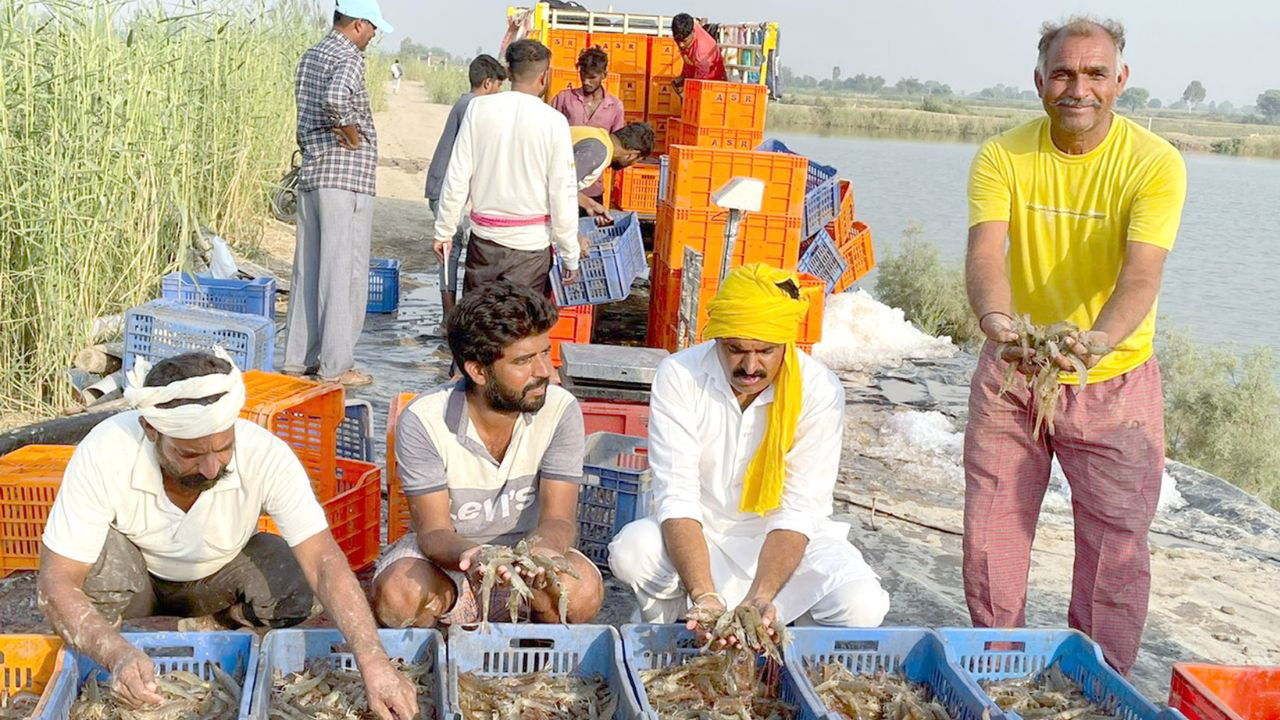
The salt-affected, waterlogged, zero-earning waste lands in south-western Punjab are now potentially being used for aquaculture, with lucrative economic returns ranging from Rs. 50,000 to Rs. 5 lakh per acre; this is due to the R&D initiatives of Guru Angad Dev Veterinary and Animal Sciences University. This information was revealed by Dr. Inderjeet Singh, Vice Chancellor of Varsity. He said that the underground water salinity and waterlogging in the south west part of the state (Fazilka, Sri Muktsar Sahib, Bathinda, Mansa and Faridkot districts), forced the farmers to abandon their saline water laden land and work as daily wagers for livelihood.
Although saline, but abundance of water was looked upon as a valuable resource for developing aquaculture, which led to fish and shrimp farming in inland saline water (ISW). After successful testing of vannamei shrimp farming in ISW in the village Shajrana (2013), the university successfully conducted the first commercial shrimp production trial in village Panchanwali (2014) of district Fazilka.
Witnessing the success of shrimp farming showcasing the potential scope of economic utilization of salt-affected waste lands, the state government sponsored a shrimp farming demonstration in village Ratta Khera of Sri Mukatsar Sahib district (2016), under the technical guidance of the university and Regional Centre of ICAR- Central Institute of Fisheries Education in Haryana. With active efforts of the university and promotional schemes of Department of Fisheries (DOF) of Punjab, area under shrimp farming expanded very fast from 1 acre in 2014 to 1315 acre in 2023.
Dr. Meera D Ansal, Dean, College of Fisheries shared that the utility services provided by the university during the last 10 years for water testing; seed testing; technical handholding; disease surveillance and monitoring; and capacity building, have corroborated the growth of aquaculture in inland saline areas; transforming an adversity into an unimaginable prosperity. University tested about 1500 water and 2500 shrimp samples of shrimp farmers and trained about 300 stakeholders in shrimp farming in the last 5 years.
The university is also promoting entrepreneurship among youth, including young fisheries and veterinary professionals who graduated from the university and for this purpose, the university conducted three shrimp farming demonstrations in district Fazilka in 2022, with a major focus on mitigating marketing risks through phased stocking and phased marketing strategies and reduction of production cost through recommended biosecurity measures and best management practices to secure farmer’s profit margins. The beneficiaries adopted shrimp farming effortlessly and increased their shrimp farming areas from 1 acre to 3-4 acres in a period of 2 years.
Shrimp is a sought-after export commodity and India is among the top 2 shrimp exporters of the world. The inland saline areas of northwest India are being eyed as shrimp hub of the future, being a landlocked pathogen-free resource to produce quality shrimp fulfilling international quality standards. About 1.51 lakh ha areas in southwest Punjab are documented to be affected by underground water salinity. If 2% (3000 ha) of the affected area is brought under shrimp farming, about 18,000 tons of shrimp (average productivity 6 tons/ha) of a market value of about Rs. 500 crores can be produced, which is expected to support about 70,000 livelihoods directly or indirectly in the supply chain.
Shrimp farming is a highly lucrative enterprise, if all goes well from production to marketing, net profit up to Rs. 10 lakh/ha/crop of 4 months can be earned. As per regional climate, shrimp can be cultured for 7-8 months from March/April to October/November, as low temperatures less than 15°C during winters is detrimental for survival of shrimp. Further, for sustainable development of ISW aquaculture in the state, the university is looking forward to diversifying the sector with introduction of new species like sea bass, ornamental fish and seaweeds.
Dr. Inderjeet Singh said that to promote domestic consumption in northern states, reduce production costs and fix the international marketing challenges, required policy actions have been proposed to the concerned departments and agencies of the State. University advocates the stringent application of recommended biosecurity measures at farmers’ level and the expansion of shrimp farming under regulatory governance to harmonize economic returns with food safety and environmental concerns at the national and state levels.
















